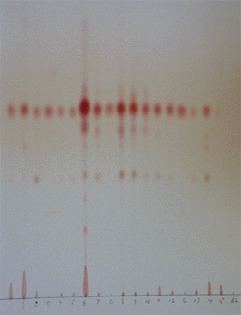 Thin Layer Chromatography (or TLC) is a "tried and true" procedure that has been used for many years in drug identification laboratories. The "thin layer" is actually a sheet of plastic coated with a porous silica material. To analyze a substance, the plant material is extracted in solvent. A spot of this extract is placed near the bottom edge of the thin layer plate. Once the spot dries, the entire plate is placed into a solvent tank, with only the bottom of the thin layer plate submerged in the solvent. Simple capillary action causes the solvent to migrate upward, eventually reaching the top of the thin layer plate. As this solvent migrates, it "pulls" the chemical components of the plant extract spot along with it. As with all forms of chromatography, some molecules will move faster than others, and at the end of the analysis, the analyst will spray the plate with a dye allowing a number of spots with a unique pattern (see example of TLC results) to be visualized. In the analysis of Marijuana, the Forensic Chemist looks for the migration of delta-9-tetrahydrocannabinol (or delta-9-THC) which is the major psycho-active component of marijuana. This spot is compared to a certified control spot of delta-9-THC.
Thin Layer Chromatography (or TLC) is a "tried and true" procedure that has been used for many years in drug identification laboratories. The "thin layer" is actually a sheet of plastic coated with a porous silica material. To analyze a substance, the plant material is extracted in solvent. A spot of this extract is placed near the bottom edge of the thin layer plate. Once the spot dries, the entire plate is placed into a solvent tank, with only the bottom of the thin layer plate submerged in the solvent. Simple capillary action causes the solvent to migrate upward, eventually reaching the top of the thin layer plate. As this solvent migrates, it "pulls" the chemical components of the plant extract spot along with it. As with all forms of chromatography, some molecules will move faster than others, and at the end of the analysis, the analyst will spray the plate with a dye allowing a number of spots with a unique pattern (see example of TLC results) to be visualized. In the analysis of Marijuana, the Forensic Chemist looks for the migration of delta-9-tetrahydrocannabinol (or delta-9-THC) which is the major psycho-active component of marijuana. This spot is compared to a certified control spot of delta-9-THC.

